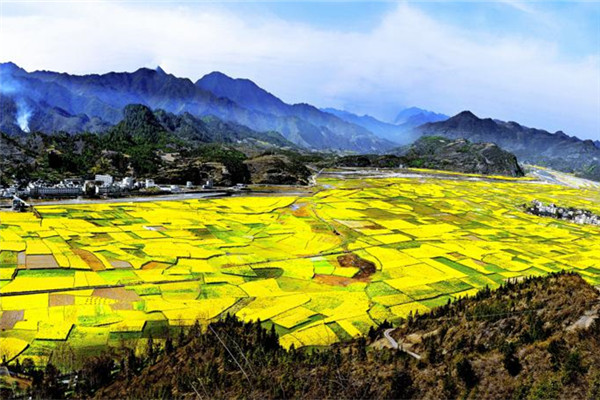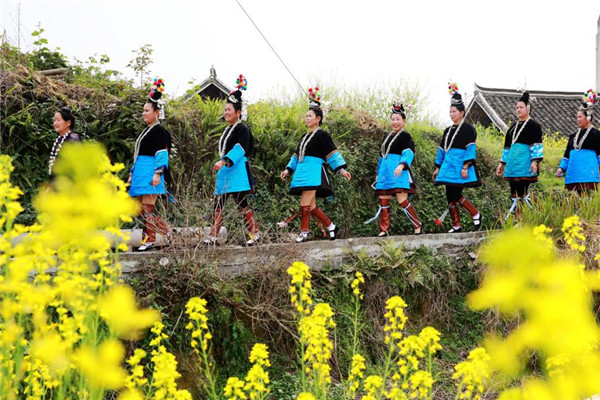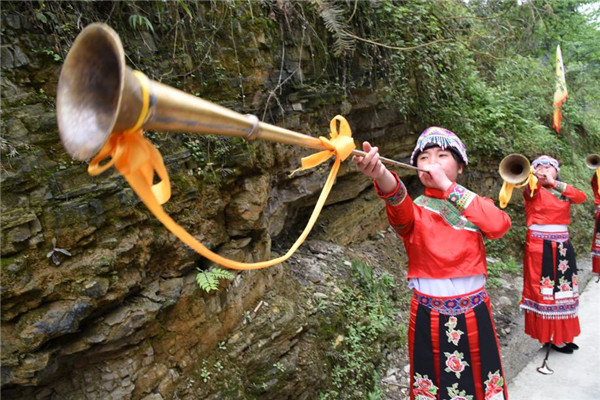
Breathtaking rapeseed blooms in Tongren, Guizhou province, draw visitors every spring.[Photo/China Daily]
In spring, Guizhou’s flowering fields lure visitors to fly kites and experience its ethnic culture.
Taiwan resident Ye Denggui visited the province’s Tongren city for a kite competition in late March, and the 53-year-old was dazzled by Huashi village’s 20,000-square-meter garden of red, pink, white, purple and yellow tulips.
“It’s fun to fly a kite in the fresh air in such surroundings,” he says.
Contestants came from China and 21 countries and regions, including the United States, Belgium and India.
The color blast will last until May.
Villagers planted tulip seedlings in December, and the tourism sector burst into bloom with them this spring. Weekend visitors have topped 5,000 since March.
The city has integrated its natural beauty and culture to bring in visitors, who explore the area’s six centuries of history and natural splendors. They also pick fruits and bamboo shoots.
Meanwhile more locals are offering farmhouse stays to the growing number of visitors.
“We can also increase our incomes by introducing tourists to local rural food,” says Huashi resident Tang Xuekui.

Women of the Dong ethnic group in Rongjiang county, Guizhou province, parade in their villages to pray for a good harvest in spring.[Photo/China Daily]
While tulips are a new addition to Tongren’s flower power, its rapeseed blooms have drawn sightseers to Wawu village for years.
But Tongren is just the tip of Guizhou’s booming tourism.
Guizhou and Zhejiang province’s capital, Hangzhou, were the only two places in China The New York Times listed among its “52 places to go in 2016”.
The province’s spring scenery enticed 9.58 million visitors during the recent three-day Tomb Sweeping Day holiday, 30 percent more than during the same period last year.
Tourism income rose 32 percent to 4.9 billion yuan ($758 million).
Guizhou hosts a stunning natural beauty preserved in its karst formations, says the provincial tourism authority’s deputy director, Tan Aiying.
And flowers make springtime the most magnificent season.
Some destinations, like Bijie and Zunyi cities, have taken flower-viewing to new heights-in every sense.
Bijie has introduced helicopter rides to view the azaleas, while Zunyi has constructed the province’s first mountain-climbing route that’s expected to open in May.
Even amateurs can climb up the rock face, using iron handrails and cables. It is one of fewer than 10 such routes nationwide.
Tea picking, processing and tasting events also enticed tourists around Tomb Sweeping Day.

People perform at a wedding in Danfeng county.[Photo/China Daily]
Guizhou’s most popular sites include the Huangguoshu Waterfall, Libo and the ethnic Miao village of Xijiang.
Most trips to the province offered by China’s biggest online travel agency, Ctrip, last roughly five days and cover all three destinations.
April excursions cost a bit north of 3,000 yuan.
As an added attraction, Guizhou offers free access to major scenic spots, and hotel and transportation discounts to visitors from Zhejiang’s Ningbo, Jiangsu province’s Suzhou, Shandong province’s Qingdao and Liaoning province’s Dalian.
Speaking of the incentives, the provincial tourism authority’s deputy director, Mou Yong, says: “These are developed cities and important sources of tourists to Guizhou.”
The province has also signed agreements with Suzhou’s travel agencies and scenic attractions.
Suzhou Travel Service chairman Bao Zhijun says: “Guizhou’s landscapes also appeal to tourists from Suzhou.”
In a related development, Ningbo will train Guizhou’s tourism professionals and annually award three agencies from the city that send the most visitors to Guizhou, says the Guizhou tourism authority’s director, Li Yonghui.
The province may also emulate the model used at Hangzhou’s West Lake, where free admission has boosted visits to the city.
“Guizhou will adopt this development mode,” says Mou.

Tourists take photos in a field of tulips.[Photo/China Daily]
But it’ll take time, considering many of the province’s attractions need massive investments in infrastructure and maintenance.
Separately, transportation has greatly improved in recent years.
Now, Longdongbao International Airport in the provincial capital, Guiyang, offers 13 flights to and from popular destinations abroad, including Thailand’s Bangkok and Phuket, Japan’s Osaka and Nagoya, and Indonesia’s Bali.
High-speed rail transport has also boosted visitor numbers.
Tourists can now hop onto buses to major scenic spots throughout the province from right outside train stations, says Mou.
All of Guizhou’s counties became accessible by highway last year.
Ye says the improved transport system means he’ll likely return.
“I’ve heard about many other attractions,” he says.
“I’ll definitely return.”
